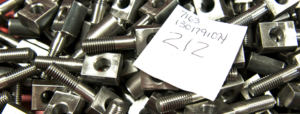
The world of milling and machining was forever changed with the introduction of computer numerated control, otherwise known as CNC Milling. Computer numerated control is a process in which a computer takes input from a Computer Aided Design (CAD) software and converts it into numbers, which are then used as coordinates that control the movement of the cutter of the machine. Motion is created among multiple axes (a differing amount depending on the type of machine being used) and a spindle which is used to do the actual drilling.
Depending on the type of product being created and type of material being used, there are different CNC milling machines that are more preferable for different applications. The amount of axes being used, the amount of control needed for the machine and the size of the product being made will all have an impact on the type of machine being used. So, what type of machine is best for creating your product? Find out below.
Vertical Mill
The orientation of the mill being used has a great affect on the product being made. A vertical mill simply means that the spindle axis on the mill is vertically oriented. Milling cutters are positioned on the spindle of the vertical mill, allowing the machine to easily cut into the material as needed. The shape, angle, and size of the milling cutter are all dependent on the type of product being made, with the different characteristics amounting to different textures and coatings.
Turret Mill
Whether or not the spindle is mobile is dependent upon the type of vertical mill being used. With a turret mill, the spindle is stationary while the table below it moves both perpendicular and parallel to the spindle axis. A quill is usually found in turret mills, which allows the milling cutter to move up and down as needed. The turret mill allows items to be vertically cut either by the milling cutter moving vertically or the table moving vertically. The turret mill is the most versatile vertical mill; however, they are most effective when the machines remain relatively small, so that the tables and the spindle have easier mobility.
Bed Mill
A bed mill is similar to a turret mill, however, the table of the machine only moves perpendicular to the spindle, opposed to perpendicular and parallel. The spindle is the only part of the machine that moves parallel to the axis, creating a more confined production. Bed mills are also considered to be more rigid than a turret mill.
Horizontal Milling
Horizontal mills function almost the same way as vertical mills, except that the cutters are mounted on a horizontal arbor. Instead of drilling into an object, an arbor shaves unwanted material from a project off, which is why it’s horizontal instead of vertical. Horizontal mills also include a universal table, which allows the product to be cut at various angles and adds to the versatility of the machine.
Generally, horizontal mills are used to cut grooves and slots into a product. However, specialty cutters can also be used to cut bevels and radii, but these specialty cutters tend to be more expensive. Horizontal mills are most commonly used to cut gears.
